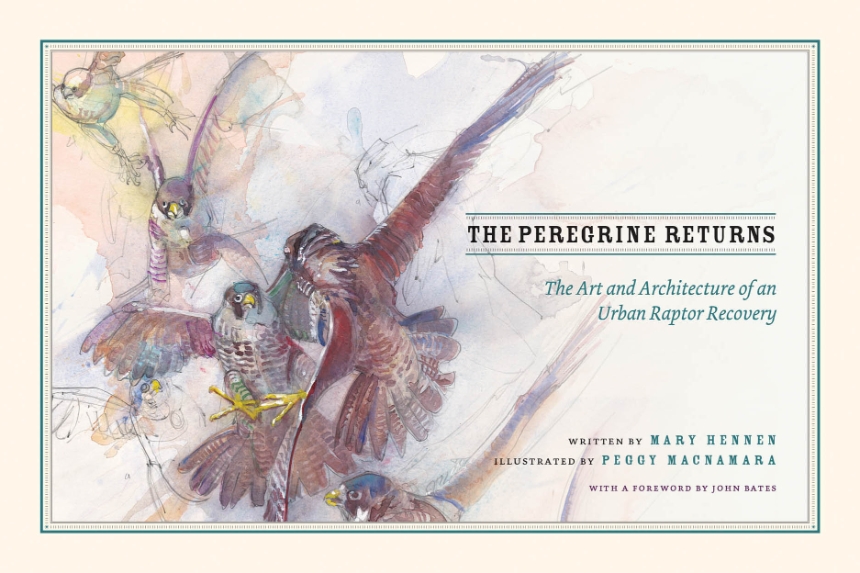The Peregrine Returns
The Art and Architecture of an Urban Raptor Recovery
9780226465425
9780226465562
The Peregrine Returns
The Art and Architecture of an Urban Raptor Recovery
Peregrine falcons have their share of claims to fame. With a diving speed of over two hundred miles per hour, these birds of prey are the fastest animals on earth or in the sky, and they are now well known for adapting from life on rocky cliffs to a different kind of mountain: modern skyscrapers. But adaptability only helps so much. In 1951, there were no peregrines left in Illinois, for instance, and it looked as if the species would be wiped out entirely in North America. Today, however, peregrines are flourishing.
In The Peregrine Returns, Mary Hennen gives wings to this extraordinary conservation success story. Drawing on the beautiful watercolors of Field Museum artist-in-residence Peggy Macnamara and photos by Field Museum research assistant Stephanie Ware, as well as her own decades of work with peregrines, Hennen uses a program in Chicago as a case study for the peregrines’ journey from their devastating decline to the discovery of its cause (a thinning of eggshells caused by a by-product of DDT), through to recovery, revealing how the urban landscape has played an essential role in enabling falcons to return to the wild—and how people are now learning to live in close proximity to these captivating raptors.
Both a model for conservation programs across the country and an eye-opening look at the many creatures with which we share our homes, this richly illustrated story is an inspiring example of how urban architecture can serve not only our cities’ human inhabitants, but also their wild ones.
In The Peregrine Returns, Mary Hennen gives wings to this extraordinary conservation success story. Drawing on the beautiful watercolors of Field Museum artist-in-residence Peggy Macnamara and photos by Field Museum research assistant Stephanie Ware, as well as her own decades of work with peregrines, Hennen uses a program in Chicago as a case study for the peregrines’ journey from their devastating decline to the discovery of its cause (a thinning of eggshells caused by a by-product of DDT), through to recovery, revealing how the urban landscape has played an essential role in enabling falcons to return to the wild—and how people are now learning to live in close proximity to these captivating raptors.
Both a model for conservation programs across the country and an eye-opening look at the many creatures with which we share our homes, this richly illustrated story is an inspiring example of how urban architecture can serve not only our cities’ human inhabitants, but also their wild ones.
208 pages | 159 color plates | 6 x 9 | © 2017
Biological Sciences: Behavioral Biology, Conservation, Ecology, Natural History
Reviews
Table of Contents
Foreword
Chapter One
By John Bates
IntroductionsChapter One
Decline of the Peregrines
Chapter TwoEffects of DDT
Chapter ThreeReintroduction
Chapter FourPeregrine Life in the City
Chapter FiveBehaviors
Chapter SixNest Site Selection
Chapter SevenNest Fidelity
Chapter EightFlight
Chapter NinePrey
Chapter TenBanding
Chapter ElevenResearch
Chapter TwelveEducation
Chapter ThirteenPeregrine Dispersal
Chapter FourteenCultural Nest Locations
Chapter FifteenCrib Peregrines
Chapter SixteenLandmark Buildings
Chapter SeventeenUptown
Chapter EighteenIndustrial Sites
Chapter NineteenThree of Chicago’s Eyries
Chapter TwentyLiving with Peregrines
Chapter Twenty-OneAnother Opinion
Chapter Twenty-TwoCity Wildlife
Chapter Twenty-ThreeNot a Peregrine?
Chapter Twenty-FourUrban Green Space
Chapter Twenty-FiveBird-Friendly Architecture
Chapter Twenty-SixConservation and Natural History Museums
Chapter Twenty-SevenA Species Recovered
Acknowledgments